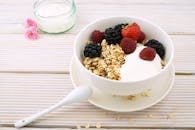By A.Geri

When choosing between rolled oats and spelt oats, both are nutritious options, but they differ in their nutrient profile and health benefits. Understanding these differences can help you make an informed choice depending on your dietary needs.
Rolled Oats: Nutritional Quality
1. Macronutrients:
- Calories: Rolled oats are relatively low in calories, with around 150 calories per ½ cup serving.
- Carbohydrates: They are a great source of complex carbohydrates, offering about 27 grams per serving.
- Fiber: Rolled oats are high in soluble fiber, particularly beta-glucan, which can help lower cholesterol levels. They provide about 4 grams of fiber per serving.
- Protein: Oats are one of the higher-protein grains, with around 5 grams of protein per serving.
- Fat: Low in fat, with only about 2.5 grams per serving, primarily unsaturated fats.
2. Vitamins and Minerals:
- B-Vitamins: Rich in B-vitamins, particularly thiamine and riboflavin, which are crucial for energy production.
- Iron: A good source of iron, contributing to better oxygen transport in the body.
- Magnesium, Phosphorus, and Zinc: These minerals support bone health, muscle function, and the immune system.
3. Health Benefits:
- Heart Health: The soluble fiber in oats can help reduce LDL cholesterol, lowering the risk of heart disease.
- Digestive Health: The fiber content also supports gut health and regular bowel movements.
- Blood Sugar Control: Oats have a low glycemic index, making them a good option for people managing their blood sugar levels.
Spelt Oats: Nutritional Quality
1. Macronutrients:
- Calories: Similar to rolled oats, spelt oats offer around 150-170 calories per ½ cup serving.
- Carbohydrates: Spelt oats are also rich in carbohydrates, with about 30 grams per serving.
- Fiber: Slightly less fiber than rolled oats, with around 3-4 grams per serving, but still beneficial for digestion.
- Protein: Spelt is known for its higher protein content, offering about 6 grams per serving.
- Fat: Low in fat, with about 1-2 grams per serving, mostly unsaturated fats.
2. Vitamins and Minerals:
- B-Vitamins: Contains B-vitamins like niacin and thiamine, which help convert food into energy.
- Iron: Spelt is also a good source of iron, supporting the production of hemoglobin.
- Magnesium and Phosphorus: These minerals contribute to bone health and energy production.
- Manganese: Spelt is particularly rich in manganese, which supports metabolism and bone formation.
3. Health Benefits:
To sum up: Both rolled oats and spelt oats are nutritious and offer unique benefits:
- Fiber Content: Rolled oats have a slight edge in fiber content, particularly in beta-glucan, which is beneficial for heart health and cholesterol management.
- Protein Content: Spelt oats are higher in protein, which is beneficial for those looking to increase their protein intake.
- Digestibility: Spelt may be easier to digest for some, especially those with mild gluten sensitivities, although it still contains gluten.
- Nutrient Density: Spelt oats are slightly more nutrient-dense, offering higher levels of certain minerals like manganese.
Final Verdict: If heart health and fiber intake are your primary concerns, rolled oats might be the better choice. However, if you’re looking for a more protein-rich, nutrient-dense option, spelt oats could be the way to go. Both can be excellent additions to a balanced diet, depending on your specific nutritional needs.

